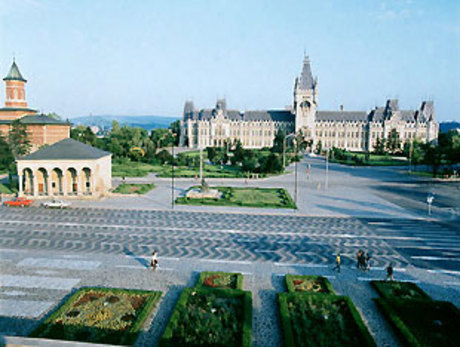Moldova Philharmonic House
The musical history of Iaşi and Romania have been closely connected to European musical history, one of the noteworthy events being Franz Liszt's concerts in 1847. In 1860 the Music and Declamation School (later the Music and Drama Conservatory) was founded. After an unsuccessful attempt in 1868, the "George Enescu" Philharmonic Society was finally founded in Iasi, in 1918.
"Moldova" State Philharmonic, an institution with permanent artistic activity, held its inaugural concert on October 9, 1942, conducted by George Enescu. After 1942, the repertoire of the Iasi symphonic orchestra became the central concern of the musicians. Professor Radu Constantinescu – its first director – and other supporters of the newly-established institution had put together an ensemble which programmed the most prominent pieces of the symphonic repertoire; thus, in its first decade, the ensemble acquired a very diverse and rich symphonic repertoire, the basis for the subsequent development of its own interpretive style.
In spring 1953 an important event opened new and promising perspectives for artistic development: the Choir was founded. The choral ensemble, established through the efforts of Professor George Pascu and composer Achim Stoia – then director of the Philharmonic – was one of the earliest ensembles of this kind in Romania. It was named after the great Romanian composer and conductor Gavriil Musicescu. The join of the choir made possible the performance – for the first time in Iasi – of Beethoven's 9th Symphony (June 4, 1954), Mozart's Requiem (May 27, 1955), Haydn's "The Seasons" Oratorio (April 26, 1957), Verdi's Requiem (February 17, 1961) and Carl Orff's "Carmina Burana" Cantata (January 19, 1962).
In 1958, Ion Pavalache followed in Professor George Pascu's footsteps, leading the choir through a period of over three decades of rich and diverse artistic activity. In 1962, the young Ion Baciu became the resident conductor of the Iasi symphonic orchestra, thus marking the second crucial moment in the life of the Philharmonic.
Ion Baciu rapidly became a leading personality in the musical life of the city. Soon after his arrival, he began assembling his now-famous "super-orchestra", substantially rejuvenating the symphonic ensemble through the addition of Conservatory students. Moreover, sensing the potential of Iasi’s resources – such as the local propensity for strings – and listening to his own personal affinities, Ion Baciu created what maestro Elenescu called "a symphonic team", or, in the words of the musicologist Iosif Sava – "Baciu's Stradivarius".
Another high point of the Ion Baciu era was the interpretation in Iasi, in 1975, and later in Bucharest, in 1981 – as part of the George Enescu centennial celebrations – of the opera "Oedipe". Showing a remarkable skill for every aspect of dramaturgy – including composition, orchestration, directing, and scenography –, maestro Ion Baciu succeeded in staging a very interesting and well received concert version of Enescu's masterpiece.
After 1970, when the orchestra had already shaped its artistic personality, Ion Baciu brought it onto the national music stage and very soon onto the international one. Starting with 1971, the orchestra had gone on tour every year, becoming increasingly better known, coming into contact with a new repertoire, and building its versatility to any style and genre.
The Iasi Philharmonic became thus a constant and appreciated presence in the concert halls in Romania – chiefly in Bucharest – and abroad: the Beethoven Hall in Bonn, the Antique Theatre in Macerata (Italy), the Concertgebouw in Amsterdam, the Meistersingersaal in Nuernberg, the Edvard Grieg Hall in Bergen (Norway), Salle Gaveau in Paris, the Madrid Auditorium, Gewandhaus in Leipzig, Tonhalle in Zurich, Gasteig in München… The orchestra has also played at venues in New York, Washington, Chicago, San Francisco, Boston, Los Angeles, as well as in Vancouver, Edmonton, Ottawa, Toronto, Montreal…
Since 1990, the Symphonic Orchestra of the Iasi Philharmonic has played annually for the final stage and the laureates' gala of the "Grand Prix Maria Callas" contest in Athens. The fruits of the thousand hours of rehearsing with Ion Baciu are visible today: after more than 30 years, the Iasi musicians are known for their professionalism, rigorousness, and discipline, backed by an inexhaustible enthusiasm.
The presence of two artistic ensembles within the Iasi Philharmonic – the Symphonic Orchestra and the "Gavriil Musicescu" Academic Choir – made possible performances of works from the vocal-symphonic and opera repertoire, as well as an impressive number of a cappella works – Romanian and international masterpieces. In parallel with their stage activity, the Iasi Philharmonic ensembles have recorded thousands of hours of music of the most diverse type and from various eras, written by Romanian and international composers, on albums, at the radio and on television.
Between 1980 and 1991, Voces String Quartet was the third resident ensemble of the Iasi Philharmonic. In 1986, conductor Ion Baciu left the Iasi Philharmonic. His successor – for the next 13 years 1988–2001 was Gheorghe Costin. Between 1995 and 2001, the young Camil Marinescu joined him. Between 1998 - 2009, a third conductor became the resident conductor of the Philharmonic, Alexandru Lascae. Since 1990, the conductor and mentor of the "Gavriil Musicescu" Academic Choir has been Doru Morariu.
In 2003, the Iasi Philharmonic granted the title of "Principal Guest Conductor" to the Italian conductor Michele Santorsola. Between 2007-2010, Michele Santorsola was resident conductor of the Philharmonic. In 2004, the Iasi Philharmonic granted the title of "Principal Guest Conductor" to the American conductor Paul Nadler. In March 2006, the same title was granted to the German conductor Mark Mast. At the time being, the Symphonic Orchestra has 63 permanent members and 10 associates; the "Gavriil Musicescu" Academic Choir has 59 permanent members and 10 permanent associates. In April 2008, the "Ad libitum" String Quartet joined the main artistic ensembles of the "Moldova" Philharmonic in Iasi.


